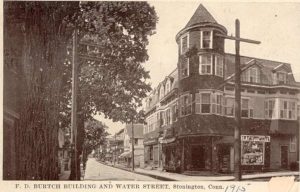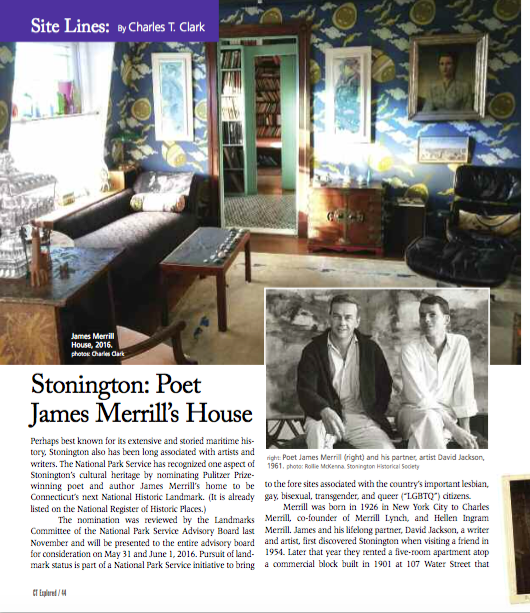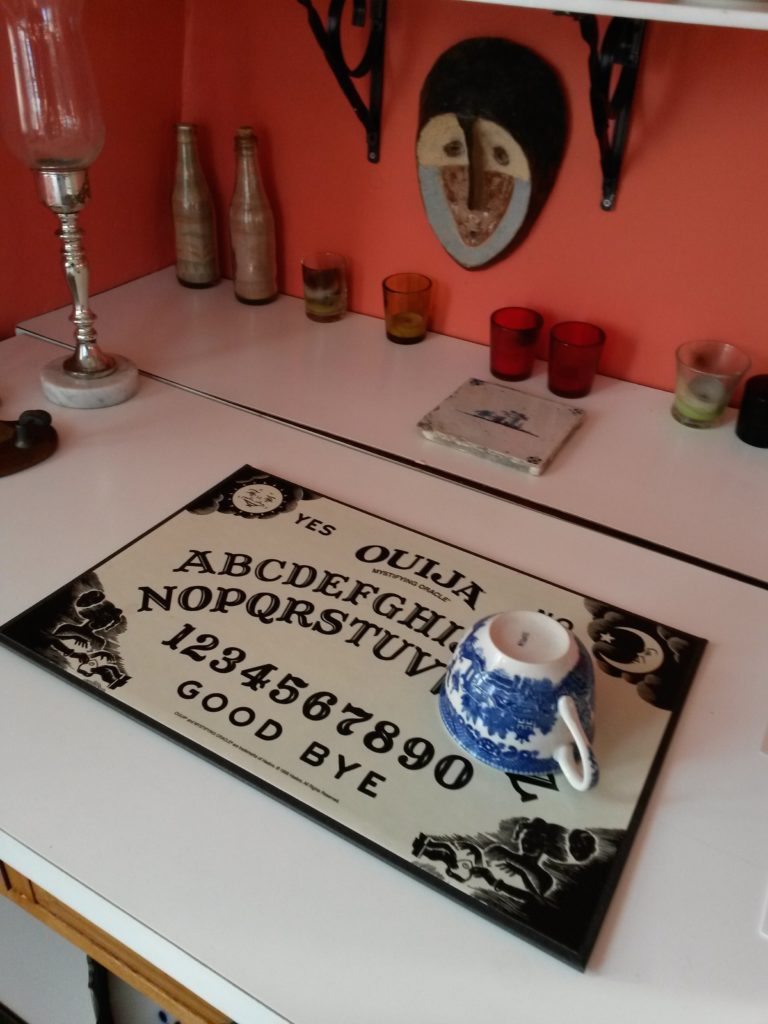by Charles T. Clark
(c) Connecticut Explored Inc. SUMMER 2016
Subscribe/Buy the Issue!
Hear a reading by the James Merrill House’s poet-in-residence with Grating the Nutmeg, the podcast of Connecticut history: Poetry and Patriots in Stonington!
Perhaps best known for its extensive and storied maritime history, Stonington also has been long associated with artists and writers. The National Park Service has recognized one aspect of Stonington’s cultural heritage by nominating Pulitzer Prize-winning poet and author James Merrill’s home to be Connecticut’s next National Historic Landmark.
The nomination was reviewed by the Landmarks Committee of the National Park System Advisory Board last November and will be presented to the entire advisory board for consideration—and, we hope, approval—on May 31 and June 1, 2016.
Pursuit of landmark status is part of a National Park Service initiative to bring to the fore sites associated with the country’s important lesbian, gay, bisexual, transgender, and queer (“LGBTQ”) citizens.
Merrill was born in 1926 in New York City to Charles Merrill, co-founder of Merrill Lynch, and Hellen Ingram Merrill. James and his lifelong partner, David Jackson, a writer and artist, first discovered Stonington when visiting a friend in 1954. Later that year they rented a five-room apartment atop a commercial block built in 1901 at 107 Water Street that offered privacy and dramatic views of Stonington harbor. Within two years Merrill had bought the entire building and expanded its living quarters into the attic and onto a new outdoor deck. This aerie provided further vistas over village rooftops to Fishers Island Sound and the ocean beyond.
 The building, known as the Burtch Block, once housed a pharmacy, other commercial tenants, clubs, and apartments. The clapboard and shingle exterior is a lively assortment of colonial revival and shingle style motifs with a dramatic, cantilevered, three-story, semi-circular tower at the southwest corner. In his National Historic Landmark nomination historian Grey Pierce notes that the Merrill House retains a “high degree of historical and architectural integrity.…” Two of the commercial tenants from Merrill’s era, barber Doug Radicioni and women’s clothing store The Hungry Palette, remain in place today.
The building, known as the Burtch Block, once housed a pharmacy, other commercial tenants, clubs, and apartments. The clapboard and shingle exterior is a lively assortment of colonial revival and shingle style motifs with a dramatic, cantilevered, three-story, semi-circular tower at the southwest corner. In his National Historic Landmark nomination historian Grey Pierce notes that the Merrill House retains a “high degree of historical and architectural integrity.…” Two of the commercial tenants from Merrill’s era, barber Doug Radicioni and women’s clothing store The Hungry Palette, remain in place today.
Merrill and Jackson initially used Stonington as a seasonal refuge from their life in New York City and later as a base from which to travel to Key West, Greece, and other destinations. Stonington had an artistic community of its own: author Stephen Vincent Benet (1898 – 1943) had lived there; novelist Grace Stone (1891 – 1991), who had a string of successes in the 1930s and 1940s, was a summer resident. Her daughter, Eleanor Perenyi, was an essayist and editor. There were others, too, including pianist George Copeland, a living link to composer Claude Debussy. During their 40-year residency, Merrill and Jackson added to this list by hosting many literary dignitaries, including Truman Capote, Mary McCarthy, and Elizabeth Bishop.
Nomination of the Merrill House coincided with publication of Yale University professor of English and American studies Langdon Hammer’s full-length biography James Merrill: Life and Art (Alfred A. Knopf, 2015) last April. Hammer places Merrill at the forefront of the country’s literary establishment for the last half of the 20th century. While examining much of his poetry, Hammer also discusses Merrill’s essays, fiction, and plays. Over the course of his long and productive career Merrill won many prizes, including the Pulitzer Prize, the National Book Award, and the Bollingen Prize for Poetry.
According to Hammer, Stonington allowed Merrill and Jackson a certain amount of freedom and anonymity—and distance from Merrill’s demanding, divorced parents. Merrill and Jackson decorated their home with a fearless assortment of Victorian objects, Japanese-inspired wallpaper, modernist furniture, and tropical colors. The decor was a broad leap from the staid formality of Merrill’s youth.
In their nomination, National Park Service historians Grey Pierce and Caridad de la Vega emphasize the ways in which 107 Water Street, and life in Stonington, influenced Merrill’s work. His epic poem “The Changing Light at Sandover,” which describes in detail the apartment’s round, coral-colored dining room, was shaped in part through countless Ouija-board séances at the dining room table.
At his death in 1995, Merrill left the building and the contents of his apartment to the Stonington Village Improvement Association (“SVIA”). The SVIA formed The James Merrill House Committee, whose volunteers now supervise all aspects of Merrill’s Stonington legacy, including fundraising, maintenance, public events, collections management, and a writer-in-residence program. Since 1995 the list of distinguished residents includes Dante scholar Peter Hawkins, essayist and poet Kelle Groom, and playwright Dan O’Brien.
Although Merrill and Jackson are long gone, the creative legacy of 107 Water Street remains vital. Resident scholars seem to thrive in this environment. After her October 2015 residency, novelist Julia Glass wrote, “Merrill’s quirky apartment, with its lavish colors, eccentric knickknacks, hundreds of books—and gorgeous views of the town and the water—is like an opium den for the imagination.”
 Charles T. Clark has been writing about Connecticut art, architecture, and culture since 1978. He has an M.S. in historic preservation from University of Vermont. He lives in Stonington.
Charles T. Clark has been writing about Connecticut art, architecture, and culture since 1978. He has an M.S. in historic preservation from University of Vermont. He lives in Stonington.
Connecticut Explored received support for this publication from the State Historic Preservation Office of the Department of Economic and Community Development with funds from the Community Investment Act of the State of Connecticut.
Explore!
The James Merrill House is accessible to the public during occasional open house events; its website is well worth a visit for information about Merrill, the house, and a calendar of programs and events. Jamesmerrillhouse.org.
 HEAR a reading by the James Merrill House’s poet-in-residence with Grating the Nutmeg, the podcast of Connecticut history: Poetry and Patriots in Stonington!
HEAR a reading by the James Merrill House’s poet-in-residence with Grating the Nutmeg, the podcast of Connecticut history: Poetry and Patriots in Stonington!



